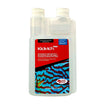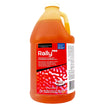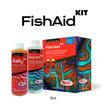- No products in the cart.
Tips For Maintaining A Healthy Aquarium In A Hospital Tank
05
Jul

Maintaining a vibrant and healthy aquarium is a rewarding yet challenging endeavor, particularly when your aquatic pets fall ill. In such instances, hospital tanks—specialized, separate tanks used for the treatment of sick, injured, or newly introduced fish—become invaluable. These tanks are crucial for preventing the spread of disease, managing aggressive behaviors, and acclimating new fish to aquarium life. This blog explores the importance of hospital tanks for fish, their setup, and how to effectively use them to ensure your fish recover swiftly and safely.
What is a Hospital Tank?
A hospital tank, often referred to as a quarantine tank, is a small, auxiliary aquarium setup used to isolate fish from the main display tank. Its primary purpose is to provide a controlled environment for treatment without the risk of transmitting diseases to healthy tank mates. Hospital tanks are not just for sick fish; they're also used for observing new or stressed fish before they join the main aquarium community.
Reasons to Use a Hospital Tank
1. Disease Treatment: When fish exhibit signs of illness, a hospital tank allows for targeted treatment without affecting other aquatic life or the water quality of the main tank. Medications can alter water chemistry and may be harmful to other fish, plants, or invertebrates.
2. New Fish Quarantine: Introducing new fish directly into your main tank can be risky. A quarantine period in a hospital tank helps ensure that new arrivals do not introduce pathogens to your established community.
3. Aggression Management: Sometimes, fish may need to be separated due to aggressive behavior or bullying. A hospital tank provides a safe haven for vulnerable fish until a solution is found.
Setting Up a Hospital Tank
Equipment Needed:
Aquarium: A small tank, typically between 5 to 20 gallons, depending on the size and number of fish.
Filtration: Use an air-powered sponge filter that has been seeded with bacteria from the main tank to provide biological filtration without strong currents.
Heater: Maintaining a consistent temperature is crucial, especially when treating sick fish.
Lighting: Simple lighting or natural light is sufficient, as the focus is on healing rather than aesthetics.
Cover: A tank cover is essential to prevent fish from jumping out.
Steps to Setup:
Clean the Tank: Ensure the tank is thoroughly cleaned and disinfected if previously used.
Set Up Equipment: Install the filter, heater, and any other necessary equipment. Use water from the main tank to fill the hospital tank to help the sick fish adapt more comfortably.
Monitor Water Parameters: Before introducing fish, check the ammonia, nitrite, and nitrate levels, as well as the pH and temperature, to ensure they are suitable for your fish.
Using a Hospital Tank
1. Acclimation: When introducing fish to the hospital tank, acclimate them slowly to avoid shock. This can be done by gradually mixing some of the hospital tank water with the water in the container that the fish was transported in.
2. Treatment: Administer treatments according to the specific needs of the fish. Always follow the instructions for any medications used.
3. Observation: Keep a close eye on the fish for any changes in behavior or appearance. Regular monitoring helps gauge the effectiveness of the treatment and the fish's recovery progress.
After Care
Once treatment is complete or the quarantine period has ended, it's important to reintroduce the fish to the main tank carefully. Repeat the acclimation process to adjust the fish to the main tank conditions. Additionally, clean and disinfect the hospital tank thoroughly to prepare it for future needs.
Conclusion
A hospital tank is a critical tool for any aquarist. It not only helps in treating sick fish but also plays a pivotal role in maintaining the overall health of your aquarium community. By understanding how to set up and utilize a hospital tank effectively, you can ensure a healthier life for your aquatic pets and a more enjoyable aquarium experience for yourself. Remember, prevention is always better than cure, and a hospital tank is a key component in preventative care.





